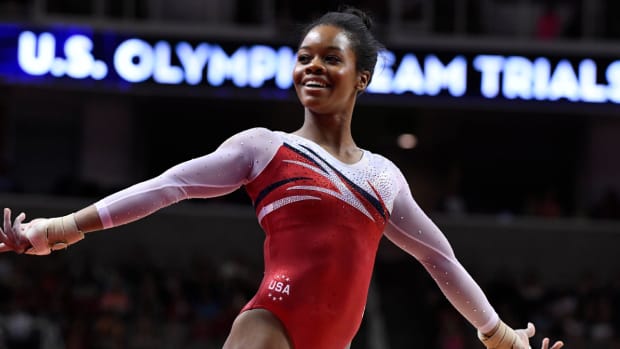Scenes from Sport Climbing's Captivating Olympic Debut
Sign up for our free daily Olympics newsletter: Very Olympic Today. You'll catch up on the top stories, smaller events, things you may have missed while you were sleeping and links to the best writing from SI’s reporters on the ground in Tokyo.
TOKYO — Before embarking on a journey into a scene that surreal fails to fully capture, first, consider this: what can you do in under 10 seconds? Can you even come up with what could do in under 10 seconds in under 10 seconds? Doubtful. Not if you’re telling the truth.
Well, when the women's sport climbers made their Olympic debut on Wednesday at the Aomi Urban Sports Park, even the slowest competitors stared up at a 15-meter wall pocked with colorful footholds, attached bungee harnesses to their bodies and climbed to the top—more like ran, jumped and wiggled—in under 10 seconds. The fastest contenders needed more like seven seconds, meaning they could fly up eight times before you could make Minute Rice.
Fortunately, many outlets have written lists of what can be done in 10 seconds or fewer. A sample: fold shirts “like a ninja,” tie shoelaces, chug a beer, send a text, or prepare 100 water balloons. Olympics sprinters, the very best of them, could finish the 100-meter dash. The 3x3 hoopers could run a single possession; not, even, if they hold the ball too long for the 12-second shot clock.
Which is to say that the speed qualification portion of sport climbing presents an absurd degree of difficulty—and it probably isn’t the hardest part. Think these climbers aren’t athletes? Try doing pull-ups with your fingertips.
At the very least, the sport’s Olympic debut on the women’s side drew the viewer in, proving compulsively watchable, if not dizzying and requiring a Google search to understand the basics. In person, it was addicting, leading to more questions than answers. Like: Are there different kinds of chalk that present competitive advantages? And what are those brushes? And why are they rubbing them on the footholds attached to the walls?
Best not to think too deeply. Not if you’re the one watching, rather than flying up a wall. The scene featured the most enthusiastic play-by-play commentator in the eastern hemisphere, a man who not only implored the crowd to cheer louder, who screamed out names and nicknames, but who reminded the athletes that their sport required “strong mental games.” Because, of course, they all needed another coach.
Booming techno music played over the speakers at the park, where fans crowded in or behind one-half of the grandstand, because that half featured the most valuable commodity here: shade. Since there aren’t technically supposed to be crowds here, the people who stood and watched—in most places, they call them crowds—made an argument for the electricity the event produced. There were volunteers, smiling and snapping photos; coaches, drawing up routes on mini-white boards, like rock wall Bill Belichicks; curious reporters, who would never attempt such maneuvers and worried they might miss dinner; and security guards, who stopped with the guarding and stood, transfixed, and watched.
This experience seemed novel to most everyone except for the participants. They understood that sport climbing isn’t new, that it’s booming, that shows like American Ninja Warrior, documentaries like Free Solo and the proliferation of climbing gyms in countries across the world point to a sport strolling into the mainstream, if not already dancing up the fringe.
The athletes, now Olympians, partook in three different types of events: speed, bouldering and lead. This wasn’t the 100 meters, the 200 and the 400. This was the 100 meters, the discus and the steeplechase.
In speed, competitors squared off, two at a time and went twice, so that each would climb both sides of the wall, since the holds on either one were mirror images of the other. (Imagine the speed climber, for instance, who can’t go left.) Most observers compared this part to Spider-Man imitations; but no, they made Spider-Man look slow, deploying power and muscle memory to combine for greater speed, then slapping a buzzer like at the end of a game show at the top. One of the competitors fell on the way up, plunging backward, kicking her arms and legs like a toddler mid-tantrum, body heaving with small sobs. The ones who made it, though, were rewarded with the coolest celebrations, arms and legs contorting while falling backward.
Stage 2: bouldering, or confronting four courses on a wall that’s wider than the speed version is tall. Competitors cannot peek at the course and must strategize while they traverse. They get five minutes to free climb to the top, and they can pick their route. But that doesn’t mean they’ll pick the right one, and that leads to contortions, bodies hanging sideways, footholds being scrubbed by those long brushes, legs split as far as they can go apart, contenders hanging upside down. This is part puzzle solving, part strategic thinking, part CrossFit. There’s quite a bit more falling.
The lead qualifying happens last, after dusk, when the stage is lit—and the competition is lit, but in the way that younger people use that word. Think music festival meets climbing gym meets what most would consider something that’s more like regular rock climbing. Every time an athlete grabs onto a hold, they score a point. Combine all three disciplines and, voila, that’s how they’re scored against each other.
Speaking of, there’s a controversy that has bubbled up there; specifically, how the Olympic competition combines all three, rather than splitting them, as usual, apart. Most climbers seem to hate the speed discipline, which means the medals may go to unlikely entrants.
Anyway, to understand what matters, watch the hands. These climbers hate sweat; according to various reporters, they bring battery-operated fans to competitions, lotion for all the cracking that results from continuous chalk application and some have been accused of dropping their hands in water with an electrical current running through it, ostensibly to deaden the nerves and lower the sweat.
Regardless, this all makes for one surreal scene. More than that, actually. It should help the sport grow, should push non-athletes to see if they can scale a wall that high in 10 seconds. Spoiler alert: good luck—and bring the lotion.
More Olympics Coverage
• Teens Sweep the Medals, Show Unique Culture of Park Skateboarding at Olympics
• Bryce Wettstein Is a Free Spirit, Flying High
• Track and Field Rivalries Power Excitement, Results at Tokyo Olympics
• Gabby Thomas Sets New Standard for Sprinters, On and Off the Track







